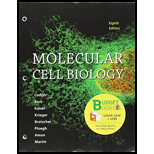
Concept explainers
To write:
The cellular mechanism that ensures the unidirectional and irreversible passage of cell cycle.
Introduction:
Different proteins or enzymes are present which regulates the transition between phases of the cell cycle. Some of them initiate the phase which some of them inhibits the phase.
Explanation of Solution
Different proteins or enzymes are involved in the process of the cell cycle which initiates or inhibits these phases of the cell cycle. During the starting of the cell cycle, inhibitors for S phase, mitotic phase, anaphase, etc. are present so that these phases do not start before completion of the G1 phase.
Cdh1 inhibitor of G1- S phase is deactivated by G1/S CDKs this initiates G1 and S phase. After this, S phase CDK inhibitor is also deactivated by SCF proteasome. After completion of S phase, mitotic CDKs are activated by Cdc25 phosphatase. This initiates mitosis phase.
Later on, in mitosis phase transition between metaphase and anaphase occurs by degradation of securing by APC proteasome. After completion of anaphase, mitotic cyclins are degraded which results in telophase and cytokinesis.
In this way step by step, initiators are activated and inhibitors are suppressed so that only the next steps take place and later and previous steps are inhibited.
During the cell cycle, at different stages, the proteins or kinase for the next stage are activated and the proteins of other stages are inhibited so that only one step occurs at a time and that in a sequential manner. This ensures unidirectional and irreversible passage of cell cycle.
Want to see more full solutions like this?
Chapter 19 Solutions
Loose-Leaf Version for Molecular Cell Biology & LaunchPad for Molecular Cell Biology (6 month access)
 Human Anatomy & Physiology (11th Edition)BiologyISBN:9780134580999Author:Elaine N. Marieb, Katja N. HoehnPublisher:PEARSON
Human Anatomy & Physiology (11th Edition)BiologyISBN:9780134580999Author:Elaine N. Marieb, Katja N. HoehnPublisher:PEARSON Biology 2eBiologyISBN:9781947172517Author:Matthew Douglas, Jung Choi, Mary Ann ClarkPublisher:OpenStax
Biology 2eBiologyISBN:9781947172517Author:Matthew Douglas, Jung Choi, Mary Ann ClarkPublisher:OpenStax Anatomy & PhysiologyBiologyISBN:9781259398629Author:McKinley, Michael P., O'loughlin, Valerie Dean, Bidle, Theresa StouterPublisher:Mcgraw Hill Education,
Anatomy & PhysiologyBiologyISBN:9781259398629Author:McKinley, Michael P., O'loughlin, Valerie Dean, Bidle, Theresa StouterPublisher:Mcgraw Hill Education, Molecular Biology of the Cell (Sixth Edition)BiologyISBN:9780815344322Author:Bruce Alberts, Alexander D. Johnson, Julian Lewis, David Morgan, Martin Raff, Keith Roberts, Peter WalterPublisher:W. W. Norton & Company
Molecular Biology of the Cell (Sixth Edition)BiologyISBN:9780815344322Author:Bruce Alberts, Alexander D. Johnson, Julian Lewis, David Morgan, Martin Raff, Keith Roberts, Peter WalterPublisher:W. W. Norton & Company Laboratory Manual For Human Anatomy & PhysiologyBiologyISBN:9781260159363Author:Martin, Terry R., Prentice-craver, CynthiaPublisher:McGraw-Hill Publishing Co.
Laboratory Manual For Human Anatomy & PhysiologyBiologyISBN:9781260159363Author:Martin, Terry R., Prentice-craver, CynthiaPublisher:McGraw-Hill Publishing Co. Inquiry Into Life (16th Edition)BiologyISBN:9781260231700Author:Sylvia S. Mader, Michael WindelspechtPublisher:McGraw Hill Education
Inquiry Into Life (16th Edition)BiologyISBN:9781260231700Author:Sylvia S. Mader, Michael WindelspechtPublisher:McGraw Hill Education





